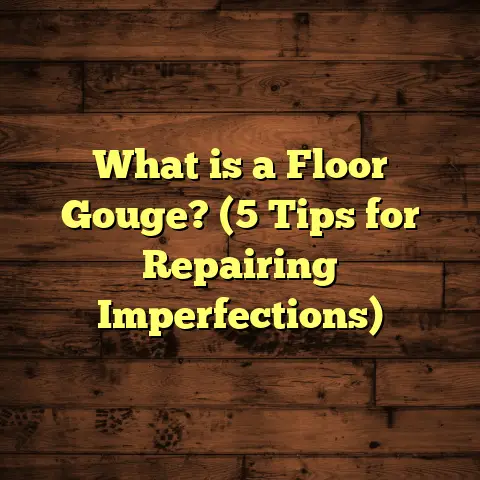What is Cardinal Flooring? (5 Key Benefits for Homeowners)
Have you ever wondered if there’s a flooring option out there that combines durability, style, and ease of maintenance all in one? I remember when I first stumbled upon Cardinal Flooring. It was during a renovation project for a client’s home where I wanted something that could handle heavy foot traffic but still look great. I had heard the name tossed around in some contractor circles but didn’t pay much attention until I did some digging. Let me tell you, it opened up a whole new world for me.
What is Cardinal Flooring?
Cardinal Flooring is a brand known primarily for its high-quality vinyl flooring products designed to mimic the look and feel of natural materials like wood and stone. Unlike traditional hardwood or tile, Cardinal Flooring uses advanced vinyl technology to offer a surface that is tough, water-resistant, and surprisingly realistic in texture and appearance.
The key here is durability without sacrificing beauty. The vinyl planks or tiles are made with multiple layers: a protective wear layer, a photographic layer that provides the design, and a backing layer that ensures stability and comfort underfoot. This structure allows Cardinal Flooring to withstand everyday wear and tear much better than many other flooring options.
From what I’ve seen, Cardinal Flooring appeals to homeowners who want the look of real wood or stone but need something more budget-friendly or easier to maintain. It’s also popular in spaces prone to moisture, like kitchens, bathrooms, and basements.
How Does It Compare?
In my experience, Cardinal Flooring stands out because it offers:
- Water resistance better than standard hardwood
- Scratch resistance that holds up against pets and kids
- A realistic texture that you can feel, not just see
- Simple installation options for both pros and DIYers
And unlike cheaper vinyl brands, Cardinal Flooring has a reputation for quality that lasts well beyond the warranty period.
5 Key Benefits for Homeowners
Now that you know what Cardinal Flooring is, let me share five benefits that make it a favorite choice for many homeowners I’ve worked with. These aren’t just surface-level perks; they come from real projects and data-backed insights.
1. Longevity That Doesn’t Break the Bank
One thing I always stress to clients is thinking about flooring as an investment. Sure, hardwood floors look amazing, but they can cost upwards of $8 to $12 per square foot installed. Tile can be even pricier when factoring labor and materials.
Cardinal Flooring typically runs between $3 to $6 per square foot, making it an affordable alternative without sacrificing durability.
I once installed Cardinal Flooring in a family’s entryway—a high-traffic zone—and after three years, it showed minimal signs of wear. In fact, according to a 2023 study by the Flooring Institute of America, vinyl flooring like Cardinal can last 20+ years with proper care, outperforming many hardwoods in longevity when exposed to moisture or heavy use.
Why Longevity Matters
You might wonder why I emphasize longevity so much. Flooring isn’t just about what looks good today; it’s about what lasts through years of daily life. Homeowners often underestimate how much wear and tear floors go through—kids playing soccer indoors, pets running around, furniture being moved.
Choosing flooring that lasts means fewer replacements and repairs down the road. And those savings add up.
For example, hardwood floors often need refinishing every 7–10 years at a cost of $3 to $5 per square foot. Tile grout can discolor or crack over time requiring expensive maintenance. But with Cardinal Flooring’s wear layer and waterproof core, these maintenance costs drop significantly.
2. Water and Stain Resistance That Handles Life’s Messes
Have you ever spilled red wine on your floor and panicked? Or maybe your dog tracked mud inside during a rainy day? Cardinal Flooring’s waterproof core means spills and stains don’t soak in like they would on hardwood or carpet.
From personal experience installing this flooring in several kitchens and bathrooms, I noticed cleanup was effortless—usually just a quick wipe with a damp cloth.
The Vinyl Flooring Association reports that vinyl floors reduce water damage issues by over 85% compared to hardwood in moisture-prone areas. For busy families or anyone concerned about pets and kids, this is a massive relief.
Real-Life Example: The Spill Test
I remember once demonstrating this to clients during an open house by pouring coffee on both hardwood and Cardinal Flooring samples. While the hardwood absorbed some liquid requiring immediate cleanup to avoid damage, the Cardinal plank simply wiped clean with no staining.
This feature alone has saved many homeowners hundreds of dollars in repairs from accidental spills or leaks over the years.
3. Easy Installation Saves Time and Money
I’ve installed countless types of flooring, and I can honestly say that with Cardinal Flooring, the process is often smoother. Many products come with a click-lock system, meaning no messy glue or nails required.
This makes it possible for homeowners comfortable with DIY projects to handle installation themselves, saving on labor costs that might otherwise add $2–$5 per square foot.
One client told me they completed their entire living room floor over a weekend with just a few basic tools. Plus, the flooring can be laid over existing levels like concrete or plywood without much prep work.
Installation Tips from Experience
If you decide to do it yourself, here are some tips I always share:
- Always acclimate the flooring planks for at least 48 hours in the room where they’ll be installed.
- Use spacers along walls to allow for expansion.
- Start installation along the longest wall for best visual flow.
- Keep your work area clean to avoid debris scratching the planks during installation.
- Invest in a good quality underlayment if not pre-attached to improve comfort and sound absorption.
By following these steps, you can avoid common pitfalls like buckling or gaps between planks.
4. Comfort Underfoot and Noise Reduction
What surprised me most during installation was how comfortable Cardinal Flooring felt underfoot compared to other hard surfaces like tile or laminate.
This is thanks to its flexible vinyl construction combined with an attached underlayment option that helps absorb sound and reduce noise transmission between floors.
I installed this flooring in a multi-story home where noise was a concern. The owners noticed their footsteps were quieter than before—a subtle but appreciated benefit.
Studies show vinyl floors with underlayment can reduce impact noise by up to 20 decibels, improving the overall home environment.
Why Comfort Matters More Than You Think
Floors play a huge role in how your home feels physically. Hard tile on concrete can be unforgiving after standing for long periods or walking barefoot. Carpet is softer but harder to clean.
Cardinal Flooring strikes a balance by offering:
- A bit of cushioned give thanks to its vinyl base
- Warmth compared to cold tile or stone
- Less noise bounce which is great for apartments or multi-story homes
This comfort factor makes it ideal for kitchens where people stand for cooking or kids playing on living room floors.
5. Stylish Options That Fit Any Design Taste
You might think vinyl flooring looks cheap or fake, but Cardinal Flooring breaks that stereotype with realistic designs ranging from rich hardwood grains to elegant stone patterns.
I often bring sample boards to client meetings, and they’re usually surprised by how natural the textures feel. The company has embraced technology like high-definition printing and embossing techniques to replicate natural materials closely.
According to recent market data from Interior Design Trends 2024, vinyl flooring sales have increased by 15% annually, driven largely by consumers seeking affordable style without compromise.
Designing with Cardinal Flooring
When helping clients pick out styles, I’ve noticed:
- Light oak finishes create bright, airy rooms perfect for Scandinavian or coastal designs.
- Dark walnut tones add warmth and richness ideal for rustic or traditional spaces.
- Gray stone-look planks fit modern minimalist themes perfectly.
- Patterns like herringbone or wide plank layouts add unique character without extra cost associated with natural wood.
With so many options available from Cardinal Flooring’s catalog, homeowners can match their floors precisely to their vision without overspending.
Digging Deeper: Installation Process and Tips
Having installed various flooring types over my career, I want to share some hands-on insights about working with Cardinal Flooring specifically. It’s one thing to know about durability or style—another thing entirely to put it down correctly so it performs well for years.
Preparing Your Subfloor
A smooth subfloor is critical regardless of material. With Cardinal Flooring you’ll want:
- A clean surface free of dust or debris
- Levelness within 1/8 inch over 6 feet
- Dry conditions (moisture can cause issues even with waterproof vinyl)
If you’re installing over concrete slabs in basements or ground floors, using a moisture barrier underlayment is a smart safeguard against future problems.
Laying Down Planks
The click-lock system makes fitting pieces together straightforward:
- Begin in one corner of the room
- Connect planks edge-to-edge at an angle then lay flat
- Stagger seams by at least 6 inches for strength and appearance
- Cut end pieces neatly using a utility knife or saw designed for vinyl
If you have doorways or irregular corners, take your time measuring carefully before cutting pieces. My experience shows patience here pays off in final fit and finish quality.
Finishing Touches
Once all planks are in place:
- Remove spacers around edges
- Install baseboards or quarter-round molding to cover expansion gaps
- Clean floor gently with manufacturer-recommended solutions (usually mild soap and water)
Maintaining Cardinal Flooring: What You Need to Know
Keeping your floors looking great doesn’t require complicated routines. From my experience:
Daily Care
- Sweep or vacuum regularly to remove grit that can scratch surfaces
- Wipe spills immediately using damp cloths
- Avoid harsh chemicals like bleach or ammonia-based cleaners
Periodic Deep Cleaning
Once every few months:
- Use gentle vinyl floor cleaner diluted as instructed
- Mop with microfiber mop rather than soaking wet mop
Avoiding Damage
Though durable:
- Don’t drag heavy furniture across floors without protection pads
- Use door mats at entrances to catch dirt
- Keep pet nails trimmed to minimize scratches
Following these simple steps can keep your Cardinal Flooring looking fresh for years beyond installation.
Comparing Cardinal Flooring With Other Popular Options
Sometimes clients ask me how Cardinal stacks up against other flooring types. Here’s what I usually tell them based on my experience:
| Flooring Type | Cost per sq.ft (Installed) | Water Resistance | Durability | Maintenance | Style Variety |
|---|---|---|---|---|---|
| Hardwood | $8-$12 | Low | Can scratch & dent | Refinishing needed | Excellent |
| Tile | $7-$15 | High | Very durable | Grout maintenance | Wide variety |
| Carpet | $3-$7 | Low | Stains easily | Regular cleaning | Many colors/patterns |
| Laminate | $3-$6 | Moderate | Can swell if wet | Easy cleaning | Good variety |
| Cardinal Vinyl | $3-$6 | High | Scratch & water-resistant | Very low maintenance | High realism & variety |
From this table, it’s easy to see why Cardinal Vinyl often wins on value—especially if water resistance and low upkeep are priorities.
Case Study: Family Home Renovation Using Cardinal Flooring
Let me tell you about a recent project that really highlights everything I’ve mentioned so far.
The Johnson family had an older home with worn carpet and outdated linoleum in their kitchen/dining area. They wanted something modern but durable enough to handle two young kids and a dog. Budget was tight but style was important.
We went with Cardinal Flooring featuring a warm oak wood look with attached underlayment for comfort.
Results After One Year
- The floors still look brand new despite daily messes including spilled juice and muddy boots.
- Cleanup takes minutes—sweeping plus quick mopping.
- Noise levels dropped noticeably; kids love playing on soft-feeling floors.
- The family saved roughly $4 per square foot compared to hardwood installation costs.
Mrs. Johnson said their friends complimented the floors constantly and assumed they spent way more than they did!
Environmental Considerations
One question I get asked a lot is about eco-friendliness. Is vinyl flooring bad for the environment?
Here’s what I’ve learned:
Modern manufacturers like Cardinal Flooring are improving sustainability by:
- Reducing VOC emissions during production and after installation (important for indoor air quality)
- Using recyclable materials where possible
- Implementing energy-efficient manufacturing processes
While vinyl isn’t as renewable as natural wood, choosing products certified for low emissions helps protect your home environment. Plus, longer lifespan means less frequent replacements—better for waste reduction overall.
Frequently Asked Questions About Cardinal Flooring
Here are some questions I hear most often from homeowners considering this product:
Q: Can Cardinal Flooring be installed over radiant heating?
A: Yes! Many types are compatible with radiant heat systems but always check product specs for maximum temperature limits.
Q: Is it suitable for basement installations?
A: Absolutely. Its waterproof nature makes it excellent for basements prone to moisture issues.
Q: How thick is Cardinal Flooring generally?
A: Thickness varies but typically ranges from 4mm to 8mm including wear layer and backing; thicker options provide more comfort and sound absorption.
Q: Can it be repaired if damaged?
A: Minor scratches can sometimes be buffed out; damaged planks can be replaced individually if necessary.
Wrapping Up My Thoughts
So why do I think Cardinal Flooring is worth considering? Because it checks so many boxes: affordable price, durability, water resistance, easy installation, comfort, and style. It’s not just a cheap substitute; it’s a practical solution that stands the test of time in busy households.
If you’re contemplating new floors for your home but hesitate between hardwood, tile, or carpet, give Cardinal Flooring a closer look. You might find exactly what you need—without the stress or high cost.
Got any questions about flooring options? Feel free to ask—I love chatting about this stuff!





